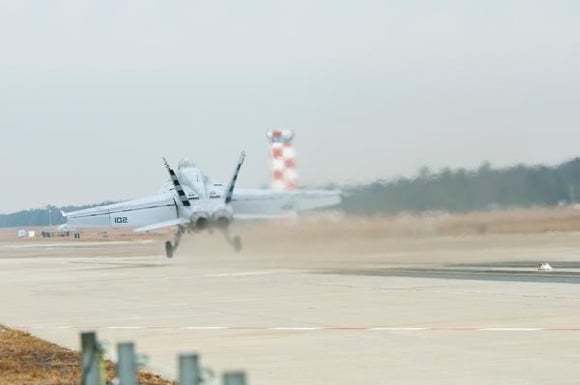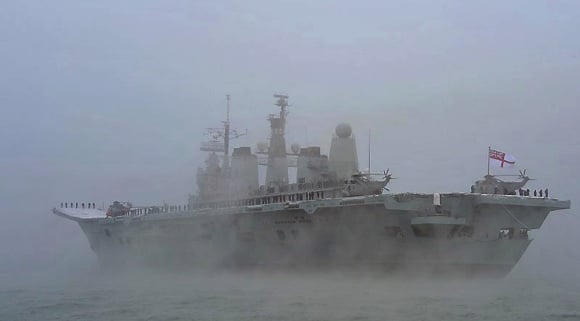Original URL: https://www.theregister.com/2010/12/21/emals_launch_success/
US Navy's electric plane-thrower successfully launches an F-18
Light at end of 10-year tunnel for Royal Navy?
Posted in Science, 21st December 2010 12:37 GMT
The US Navy says it has successfully launched a jet fighter into flight using a radical new electromagnetically powered catapult. The feat is important for the Americans, whose next supercarrier will be a disastrous botch without the new tech: it is even more critical for the future of the Royal Navy.

In with the new
The US Naval Air Systems Command (NAVAIR) announced the test success of its Electromagnetic Aircraft Launch System (EMALS) last night, saying that the shore-based trials catapult at Lakehurst, New Jersey, successfully launched a Navy F/A-18E Super Hornet on Saturday.
“I thought the launch went great,” said Lieutenant Daniel Radocaj, the test pilot who flew the Hornet off the electric mass-driver. “I got excited once I was on the catapult but I went through the same procedures as on a steam catapult. The catapult stroke felt similar to a steam catapult and EMALS met all of the expectations I had.”
The "shooter" in charge of the ground team conducting the launch was Chief Petty Officer Brandon Barr, who said being chosen for the task was an honour and that "it was very exciting to knowingly be a part of naval aviation history".
The next US fleet carrier – CVN 78, aka USS Gerald R Ford – is now at an advanced stage of build, and was designed around the EMALS. If EMALS couldn't be made to work, the US Navy would have found itself in possession of the world's biggest helicopter carrier. There will be much celebration at NAVAIR following Saturday's success.
The Royal Navy, too, could feel some muted satisfaction. Though the Fleet Air Arm has been stripped of its Harriers and their ski-jump carriers in the recent Defence cuts package, Prime Minister Cameron promised that in a decade's time (provided that the next two governments agree) the RN will re-enter the world of serious maritime aviation. It will do this using one of the two aircraft carriers now being built – the other may be mothballed or even sold. If it is mothballed, however, the option would be there to have one ship up and running almost continuously: the other likely plan is to work a solo ship back-to-back with the French.
Under the original plan, the British ships were to carry the revolutionary F-35B, the world's first ever supersonic stealth jumpjet. An F-35B, like the Harrier before it, can get airborne from a ski-jump ramp with a combat load and return to the deck (having burned fuel and expended weapons) in a hover landing. Unlike the Harrier, the F-35B is also warranted to get back aboard ship still carrying a brace of heavy air-to-air missiles* – if necessary using a cunning "rolling vertical" landing, which would have been the RN's plan. Thus HMSs Queen Elizabeth and Prince of Wales would have needed no catapults, and none are provided at the moment.
But the F-35B is a tremendously complicated machine. It will always be expensive, and it is moving slowly through flight test at present. Even in 10 years it would probably be unaffordable for Britain in any numbers. The solution chosen has been to buy F-35C catapult planes instead, the type the US Navy will be getting. These are still stealth fighters (or fighter-bombers anyway, rather more useful for most purposes) but they don't need the vertical-thrust machinery of the B model. Thus they are somewhat cheaper and have improved performance in the air.
It's cool for cats, but they'll have to be electromagnetic

Out with the old
Fitting one or both Brit carriers with catapults is simple in one way, as space was left in the designs for this to be done. The ship or ships won't have to be rebuilt. But they don't use steam in their propulsion, so they can't be fitted with steam cats: it has to be electromagnetic or nothing. Thus the news from New Jersey at least indicates that the Royal Navy's new roadmap is feasible.
EMALS is built by famous US crazytech firm General Atomics, which has also given the world the Predator and Reaper robot kill-planes, the Blitzer railgun and many other things. It seems that GA is now the only company in the world which knows how to make electromagnetic catapults.
An MoD spokesperson told the Reg this morning that the question of who will make the UK's electro-catapults has not been decided yet. It's always possible that we'll go to General Atomics: but in general British practice is to reinvent wheels ourselves at great expense rather than simply buying them from the wheel shop. The UK tentacle of French-centred multinational Converteam – the same outfit which supplied our new Type 45 destroyers' buggy electric drive units – has already done some small-scale experimental catapult work for the MoD, and it seems likely that they will be paid to duplicate the same R&D that General Atomics has just done.
Even with the switch to catapult ships and the F-35C, however, it appears that the UK will not be able to afford very many jets. The upgraded British carrier which goes to sea in 2020 – provided nothing changes – will have an air group of just 12 planes. More might be bought down the road, perhaps; though by the time Blighty actually gets round to that the USN may have moved on to unmanned ones.
However you slice it, it will be a long time until Britain is back in the carrier game. That's not such good news when one reflects that almost every time the UK has had to fight seriously at sea since 1939, control of the skies was crucial: and that the last time Blighty had a fight on its hands for that control of the skies (Falklands, 1982) the only way to get aircraft into the fight was from the decks of ships. The RAF's fleets of land-based fighters and bombers – which we have chosen to preserve at the cost of the Harrier – were of almost no use at all**.
It's to be hoped, then, that the coming decade without any RN carrier air won't mean disaster or embarrassment. (Though of course that might lead to the replacements being cancelled.) The news from Lakehurst would seem at least to offer a small light at the end of a very long tunnel. ®
Bootnote
*This was why the late, great Sea Harrier FA2 fighter was binned some years ago. It could return to the deck after a patrol armed with two AMRAAM missiles in cold weather – cold air is good for planes and engines, offering better performance. But the SHAR couldn't make a safe deck landing while it was still armed in places such as the Persian Gulf, rendering its usefulness in the modern day rather questionable: a fighter needs to be able to mount routine patrols without dumping weapons after every flight.
The remaining RN and RAF Harriers which have just retired from duty are the GR7/9 ground-attack version. These were much to be preferred for strike missions, the main employment of combat jets these days: they could also be armed with Sidewinder missiles to offer a limited air-to-air option. (The original Harrier FRS1s which won the Falklands air war had only Sidewinders – but they also had the Blue Fox fighter radar, a thing which today's GR7s and 9s lack.)
**The "Black Buck" long-range bombing missions mounted from Ascension Island with the support of almost all the RAF's air-to-air tankers were magnificent technical feats but achieved very little.